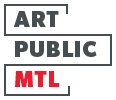
Mosaic by Geneviève Cadieux at station Saint-Lazare, in the Paris métro (2011)
In 1966, the Régie autonome des transports parisiens (RATP) gifted the City of Montréal, then in charge of building the métro, with a decorative grillwork. Designed by Hector Guimard in 1900, the architectural element, one of the most illustrious examples of Art Nouveau in France, graced many of the entrances to the Paris métro. However, the unusual dimensions of the street entrance to station Square-Victoria rendered the Montréal installation incomplete and at odds with traditional Guimard grillworks.
The grillwork was properly restored from 2001 to 2003, in close cooperation with RATP. As part of a cultural exchange, STM agreed to also gift its French counterpart with a work of art. With the support of the City of Montréal, STM launched a competition, calling on artists from the greater metropolitan area for submissions. Their work of public art had to draw inspiration from a theme agreed upon with RATP, the French language. A jury reviewed proposals by 37 artists who entered the competition, finally selecting the one by Geneviève Cadieux.
Well-known by Montrealers, the artwork installation by Geneviève Cadieux entitled La Voie lactée, sitting atop the Montréal Museum of Contemporary Art, is reproduced yet transformed at station Saint-Lazare. Seen from afar in Montréal, seen up close in Paris, La Voie lactée becomes La Voix lactée. The first is luminous and distant, the second shimmering and palpable. La Voix lactée was created with glass mosaic tiles in Franz Mayer’s studio in Munich, Germany. Its public unveiling took place on October 4, 2011, as part of the 150th anniversary of public transportation in Montréal and the 50th anniversary of the Délégation générale du Québec à Paris.
Presentation of the RATP-STM cultural exchange (In French only)
The Montréal métro became 50 years old on October 14, 2016. In anticipation of this important anniversary and in the wake of the cultural exchange completed in 2012 with the Régie autonome des transports parisiens (RATP), the STM took steps to enter into another such exchange with another métro system that shares a similar interest for integrating artwork and architecture. The Brussels métro, in Belgium, was a perfect match in this respect: in addition to having works of art inside virtually every station, it celebrated its 40th anniversary on September 20, 2016, barely a few days before the 50th anniversary of our métro.
As such, Bruxelles Mobilité, the administrative body responsible for equipment, infrastructure and mobility within the Brussels-Capital Region, gave the STM a work of art by an artist from Brussels, installed in Montréal’s station Place-d’Armes, while the STM gave Bruxelles Mobilité a work of art by a Montréal artist which, in turn, was installed in Brussels’ station Trône. Located on lines 2 and 6, station Trône serves the Léopold neighbourhood to the east, including rue du Luxembourg and the European Parliament, as well as place du Trône, the Royal Academies of Belgium, the Royal Palace, Brussels Park, and a number of other institutions to the west.
It should be noted that in 2002, the Brussels-Capital Region signed a cooperation agreement with the Government of Québec. The Délégation générale du Québec in Brussels has also expressed strong interest in a cultural exchange between the Montréal and Brussels métro systems and has offered the STM its full cooperation to help achieve it. The STM also has the support of the city of Montréal’s public art bureau and has relied on its reputable expertise in the field of arts. Lastly, the STM has solicited the cooperation of several influent public figures in the local visual arts scene to compose a jury who chose three finalists before selecting a winning proposal.
Competition program and rules (in French only)
Partner of
